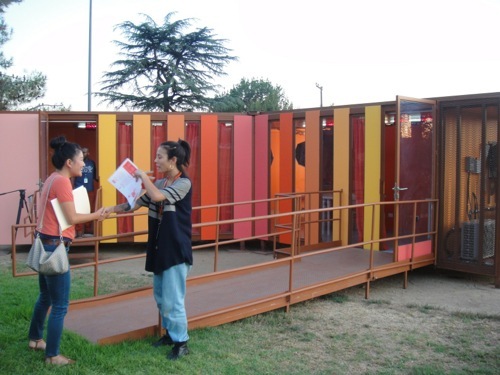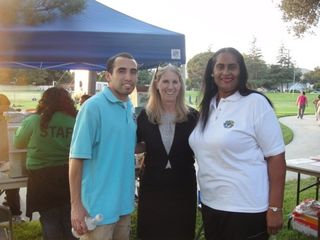Jessica Youn of LACMA welcomes visitors to the Art+Film Lab, which will be at Charles White Park through Oct. 13. Photos by Laura Monteros.
by Laura B. Monteros
It seemed serendipitous. LACMA—Los Angeles County Museum of Art—wanted to expand its outreach into communities far from the art museum with LACMA9 Art + Film Lab, and Altadena’s demographics matched the kind of community they were looking for. But the folks at LACMA got more than they dreamed of when they discovered this little gem we call home.
The first discovery was Charles White Park, named after the influential African-American artist and teacher. When the museum approached Penny Daniels, manager of Loma Alta Park, about using that site as a venue for the project, Daniels and Recreation Services Leader Sam Estrada put their heads together and offered Charles White Park as a more appropriate venue. They considered the art connection as well as the need for more programs and requests for movies in the park.
“That was the biggest thing,” Sarah Jesse, associate vice president of education at LACMA, said of the venue. “There’s a lot of his art in our collection.” LACMA even has a satellite gallery at Charles White Elementary School on the site of the old Otis Art Institute across from MacArthur Park. “His legacy is something we think about a lot,” she said.
A place for
the arts
The second was Altadena’s vibrant art and music community and
haven for one-of-a-kind characters. “It seems like a great
place,” Jesse said. “We met a lot of people while we were
prepping,” and they educated her about such Altadenans as Jirayr
Zorthian, Richard Feynman, and Zeke the Sheik.
It all came together in a celebration at the park on Friday evening, which served as an introduction to the upcoming LACMA9 Art + Film Lab that will take place over the next four weekends. Altadenan Louis Van Taylor and his combo, who played at a LACMA Friday Night Jazz program, were called on to entertain visitors prior to the screening of Le Harve, introduced by Charles White’s son Ian.
The bright orange portable lab was open for viewing and Parks and Recreation served up free hot dogs, popcorn, chips, and drinks. On Sunday from 12:30 to 4 p.m., there will be an oral history presentation and drop-in booth.
Sharing
stories
Walter Vargas, a video artist who works in the film lab, led us
around the lab and shared his excitement. There is an oral
history section, where people can talk for 30 or 40 minutes about
their lives, or just share stories. “The point is to
interact with the camera and tell stories that have never been
told,” he said. When the stories are collected, video
artist Nicole Miller will follow up on the stories she
particularly likes and combine them into a video.
LACMA9 is a program funded by a grant from the James Irvine Foundation that focuses on providing workshops in videography, still photography, and oral history in nine communities not usually reached by the museum. Along with the workshops, movies that reflect the community or its interests are shown. Altadena is the third community to host the program, and the first in Los Angeles County.
Jane Burrell, senior vice president of education for LACMA, said, “We are trying to bring LACMA out into the wider community, farther from the museum,” and the hope is that will encourage people to come to the Wilshire Boulevard museum.
The five-week program follows a basic format of collecting oral histories and showing art films on Fridays and Saturdays, and workshops on Saturdays and Sundays (except the first weekend). Workshops include mini-documentaries made in the park, soundscapes which combine ambient and created sound, composition, and editing.
A schedule is available at https://www.lacma.org/series/altadena-art-film-lab. On Sunday, Jan. 19, 2014, Altadena residents receive free admission to LACMA and can see a showing of Miller’s videos.
The lab has eight computers and 16 digital cameras available for participants. All offerings are free and are first-come, first-served. Participants are encouraged to sign up a half hour prior to each workshop, while the oral history booth is a drop-in activity. They are geared to pre-teens, teens, and adults, though Vargas said that younger children can collaborate with an adult.






